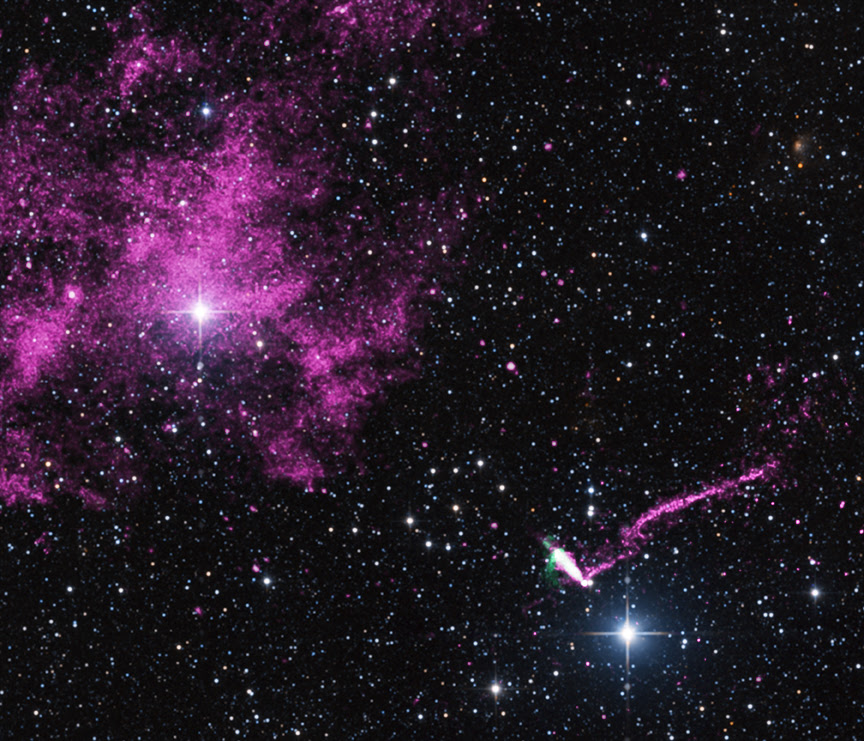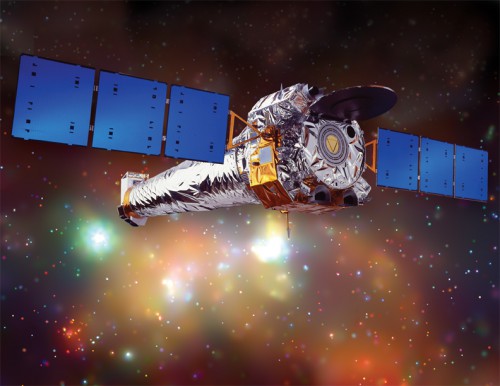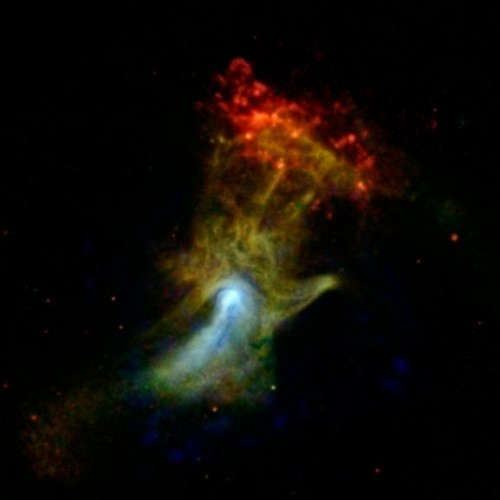
NASA’s Chandra X-Ray Observatory, the world’s most powerful X-ray telescope, recently observed an impressive, rapidly rotating neutron star—known as a pulsar—escaping from a supernova remnant roughly 15,000 light-years from Earth. The pulsar is spewing out a record-breaking 37 light-years-long jet of high-energy charged particles, making it the longest X-ray jet of any object ever seen in the Milky Way galaxy, and one of the fastest moving pulsars ever observed.
For scale, the above image spans a distance of roughly 22 Arcminutes across (about 147 light-years). The pulsar’s jet, which is visible to the bottom right as a purple tail, is 10 times longer than the distance from us to the nearest star.
The pulsar, identified as IGR J11014-6103, is the stellar corpse of the incredibly violent death of a massive star, and it’s racing away from the center of the ancient collapse and subsequent explosion (a supernova) at an implied speed somewhere between 2.5 million and 5 million mph. The dense, highly-magnetized pulsar—originally discovered with the European Space Agency (ESA) satellite INTEGRAL—is located some 60 light-years away from the center of the supernova remnant, named SNR MSH 11-61A, which is in the constellation of Carina, and it’s displaying a distinct corkscrew pattern that suggests the pulsar is wobbling like a spinning top.

“We’ve never seen an object that moves this fast and also produces a jet,” said Lucia Pavan of the University of Geneva in Switzerland and lead author of a paper published Tuesday in the journal Astronomy and Astrophysics. “An important aspect of the jet is that it is forming a helix in space. An immediate interpretation would be that the pulsar is wobbling (what is called free precession), and the helix mirrors the different launching directions of the particles. Several other pulsars (for example the Vela pulsar) are sought to wobble as well, but this hypothesis is still argument of debate in the astrophysical community, and another possible hypothesis is that these effects are due instead to instabilities that grow along the jet.”
From Pavan’s paper:
“Jets from rotation-powered pulsars have so far only been observed in systems moving subsonically trough their ambient medium and/or embedded in their progenitor supernova remnant (SNR). Supersonic runaway pulsars are also expected to produce jets, but they have not been confirmed so far. We investigated the nature of the jet-like structure associated to the INTEGRAL source IGR J11014-6103 (the “Lighthouse nebula”). The source is a neutron star escaping its parent SNR MSH 11-61A supersonically at a velocity exceeding 1000 km/s. We observed the Lighthouse nebula and its jet-like X-ray structure through dedicated high spatial resolution observations in X-rays (Chandra) and radio band (ATCA). Our results show that the feature is a true pulsar’s jet. It extends highly collimated over >11pc, displays a clear precession-like modulation, and propagates nearly perpendicular to the system direction of motion, implying that the neutron star’s spin axis in IGR J11014-6103 is almost perpendicular to the direction of the kick received during the supernova explosion. Our findings suggest that jets are common to rotation-powered pulsars, and demonstrate that supernovae can impart high kick velocities to misaligned spinning neutron stars, possibly through distinct, exotic, core-collapse mechanisms.”
Not only is the X-ray jet in IGR J11014-6103 the longest, and fastest, ever seen in our Milky Way galaxy, but it is also producing a pulsar wind nebula (PWN)—a cocoon of high-energy charged particles accelerated by the rapidly rotating, superstrong magnetic field of the spinning pulsar that enshrouds and trails behind it in a comet-like tail. Pulsar wind nebula is not something new to science, as it has been observed before—the most well-known examples probably being the Crab Nebula and the “Hand of God.” The Chandra data on pulsar IGR J11014-6103, however, shows the long jet and the pulsar wind nebula are almost perpendicular to one another, which is odd considering usually a pulsar’s direction of motion, its jet, and its PWN are aligned with one another and point in the same direction as they are moving (at least in previous observations of other pulsars).

“It was much more difficult than expected to prove our idea, but with all the multi-wavelength data we collected, we were finally able to conclude that the small comet shape is due to the wind produced by the pulsar, what is called its ‘pulsar wind nebula’,” says Pavan. “Its elongated shape is due to the speed of the pulsar, in a similar way that Mach cones are formed by supersonic airplanes. We could also confirm that the pulsar was born some 15,000 years ago during the explosion that left over the debris visible just north to it (a supernova remnant).”
Pavan adds: “The last, fundamental, piece was much harder to get solved: whether this stripe, so long and energetic, was or not a stream of particles blown away by the pulsar itself (what is called a ‘jet’). Only when we created a numerical model to simulate different aspects of a jet when seen through Chandra’s eyes, and we compared it to our data, we were finally able to prove that this is indeed a pulsar jet. It is as if the pulsar is running through the interstellar space at an incredible speed, with its two ‘arms’ stretched large, and leaving a wake behind it.”
“We can see this pulsar is moving directly away from the center of the supernova remnant based on the shape and direction of the pulsar wind nebula,” said co-author Pol Bordas, from the University of Tuebingen in Germany. “The question is, why is the jet pointing off in this other direction?”
“With the pulsar moving one way and the jet going another, this gives us clues that exotic physics can occur when some stars collapse,” said co-author Gerd Puehlhofer, also of the University of Tuebingen.
Only further investigation and observations will help answer why pulsar IGR J11014-6103 is behaving in such a way; one theory requires an extremely fast rotation speed for the iron core of the star that originally exploded, although such fast speeds are not commonly expected to be achievable.
“There will be still much more to discover and understand about this source, and about pulsars and jets formation in general –phenomena that are widespread and that here, for the first time, can be studied all at once. We hope that the new data that will arrive soon from Chandra (a much longer observation, equivalent to almost 3 days) and at several different wavelengths (for example in the optical band, with the Very Large Telescope in Chile) will help us unraveling these open questions.”
Chandra, which launched on in July 1999 onboard the Space Shuttle Columbia on mission STS-93, is specifically designed to detect X-ray emission from very hot regions of the Universe such as exploded stars, clusters of galaxies, and matter around black holes. The results from Chandra continue to help scientists and astronomers explore high-energy phenomena and provide insights into the Universe’s structure and evolution.
Want to keep up-to-date with all things space? Be sure to “Like” AmericaSpace on Facebook and follow us on Twitter: @AmericaSpace



